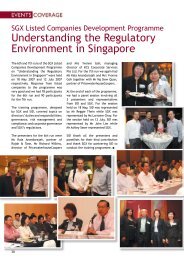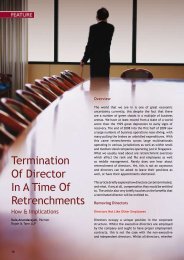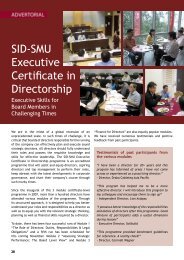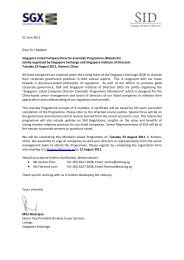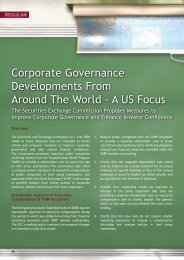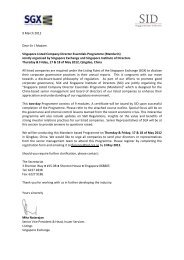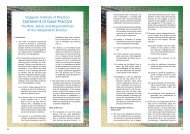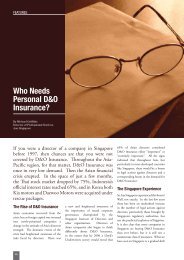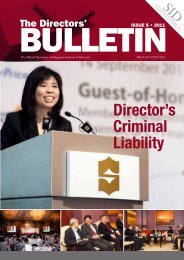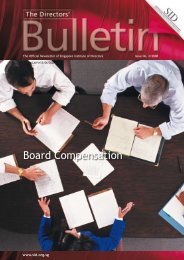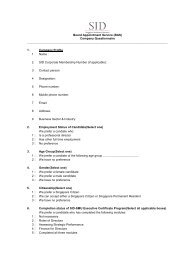Workplace Safety & Health - Singapore Institute of Directors
Workplace Safety & Health - Singapore Institute of Directors
Workplace Safety & Health - Singapore Institute of Directors
You also want an ePaper? Increase the reach of your titles
YUMPU automatically turns print PDFs into web optimized ePapers that Google loves.
<strong>Singapore</strong> <strong>Institute</strong> <strong>of</strong> <strong>Directors</strong>MISSIONSTATEMENTTo promote the pr<strong>of</strong>essionaldevelopment <strong>of</strong> directorsand corporate leaders andencourage the highest standards<strong>of</strong> corporate governance andethical conductTHE INSTITUTE’S OBJECTIVES ARE:• To be the national association <strong>of</strong> company directors for the local businesscommunity. The SID works closely with its network <strong>of</strong> members,pr<strong>of</strong>essionals such as accountants and lawyers, and the authorities toidentify ways to uphold and enhance standards <strong>of</strong> corporate governance.• To act as a forum for exchange <strong>of</strong> information on issues relating tocorporate governance and directorship in <strong>Singapore</strong>. The SID playsa leading role in holding discussions and providing feedback to theauthorities on matters <strong>of</strong> concern.• To organise and conduct pr<strong>of</strong>essional training courses and seminars tomeet the needs <strong>of</strong> its members and company directors generally. Suchcourses aim to continually raise the pr<strong>of</strong>essional standards <strong>of</strong> directors in<strong>Singapore</strong> by helping them raise their effectiveness through acquisition<strong>of</strong> knowledge and skills.• To regularly publish newsletters, magazines and other publications toupdate members on relevant issues, keeping them informed <strong>of</strong> latestdevelopments. These publications also serve as reference materials forcompany directors.• To be responsible for the discipline <strong>of</strong> members. The SID has drawn upa code <strong>of</strong> conduct for directors in <strong>Singapore</strong> setting out the standardsto ensure they discharge their responsibilities dutifully and diligently.
CONTENTSPUBLICATION & WEBSITECOMMITTEEChairmanYeoh Oon JinPricewaterhouseCoopers LLPMembersKala AnandarajahRajah & Tann LLPAdrian ChanLee & LeeMike GrayTricor <strong>Singapore</strong> Pte LtdVictor YeoNanyang Technological UniversityAnnabelle YipWong Partnership LLPPaul ZamanQualvin Advisory Pte LtdPUBLISHER<strong>Singapore</strong> <strong>Institute</strong> <strong>of</strong> <strong>Directors</strong>3 Shenton Way #15-08Shenton House<strong>Singapore</strong> 068805Tel : 65 6227 2838Fax : 65 6227 9186Email: secretariat@sid.org.sgWebsite: www.sid.org.sgEDITORKala AnandarajahDESIGNWini TenorioPRINTEREntraco Printing Pte LtdPageFROM THE EDITOR 2CHAIRMAN’S MESSAGE 3SID GOVERNING COUNCIL 4COVER STORY<strong>Workplace</strong> <strong>Safety</strong> & <strong>Health</strong> – What Have <strong>Directors</strong>Got To Do With It?FEATURESSpeech by Mr Gan Kim Yong, Minister for Manpower at theLaunch <strong>of</strong> the National WSH Campaign 2011, 20 April 2011Putting Your Fingerprints On <strong>Safety</strong> 13Tackling Dysfunctional <strong>Directors</strong> 15Panning For Gold In The Wake Of The Budget 18GST Risk Management For Enhanced Corporate Governance 21Who Needs Personal D&O Insurance? 24Steps For Safeguarding Cash & Critical Assets And Tightening 27Controls On Legal RepresentativesSID Corporate Membership 33EVENTS COVERAGE2-day LCD Programme in Shanghai, China 34UPCOMING TALKS/COURSES 36WELCOME ABOARD (New Members) 37611Sponsor:The Business Enablers1
FROM THEEDITORWelcome to another issue <strong>of</strong> the <strong>Directors</strong>’ Bulletin, issuedafter an exciting time <strong>of</strong> the <strong>Singapore</strong> elections. The wordsunprecedented and watershed, amongst others, have beenused on numerous occasions.In the director scene, nothing exciting, so to say, hasoccurred except perhaps recent court decisions imposingeven a custodial sentence. This is an evergreen reminder fordirectors, and independent directors at that, that the courtsin various jurisdictions scrutinise the performance by all types<strong>of</strong> directors <strong>of</strong> their duties and responsibilities to the companyseriously. The Companies Act makes no difference as to thetype <strong>of</strong> director appointed and hence, is a clear indication thatall directors owe the same statutory duty <strong>of</strong> acting honestlyand diligently (interpreted as with due skill and care) at alltimes. What is comforting is that at common law, the courtshave been more willing to recognise that there could be adifferent level <strong>of</strong> duty owed by different directors, dependingon their specific designation and roles in the Company.What remains clear, however, is that no director can everabdicate his duties, regardless <strong>of</strong> how limited those are. Inthis light, would a director be viewed as potentially abdicatinghis duty if he simply took the position that his only role wasoversight? There are many nuances to this question and it is notpossible to provide a simple answer; although without more, Iwould take the view that a director, even an independent one,has a wider role to play than mere oversight.I started <strong>of</strong>f the discussion in this issue <strong>of</strong> the <strong>Directors</strong>’Bulletin with a discussion on director duties for two reasons.First, the focus <strong>of</strong> this issue is on workplace safety andhealth. Many an un-enlightened individual would ask whathas workplace safety and health got to do with the directoror director’s duties. Everything I say. Although the relevantlegislation, ie the <strong>Workplace</strong> <strong>Safety</strong> and <strong>Health</strong> Act has beenaround since 1 March 2006, not many fully appreciate theboard’s role in ensuring workplace safety and health at theworkplace. This is discussed in the first and second articles inthis issue. The issue is particularly pertinent as the Act will beextended with effect from 1 September 2011 to apply to allworkplaces.Second, the <strong>Institute</strong>’s Annual Director Conference will beheld in September 2011. The theme for the conference isHeat or Hope - viewed from the perspective <strong>of</strong> directors. TheConference aims to respond to the many vexed questions thatcome up on exactly what is the duty, responsibility and so role<strong>of</strong> the director. Varied panels comprising <strong>of</strong> international andlocal stakeholders will lead discussions. Do make a date withthe <strong>Institute</strong> to attend this event.Separately from directors’ duties and responsibilities,workplace safety is an important issue to manage. To this end,we are pleased to include in this issue the speech deliveredby then Minister for Manpower, Mr Gan Kim Yong, at thelaunch <strong>of</strong> the National <strong>Workplace</strong> <strong>Safety</strong> & <strong>Health</strong> campaignon 20 April on critical steps being taken to improve workplacesafety and health in <strong>Singapore</strong>. This includes a new Messengerprogramme. It is apt and a privilege for me to take thisopportunity to thank the Minister not just for allowing usto use his speech, but more importantly, for his invaluablecontributions to safety and health in <strong>Singapore</strong>. Thank youMinister and wishing you the best in your new portfolio.<strong>Workplace</strong> safety and health is not only a localised issuein <strong>Singapore</strong> but a matter viewed seriously in a number <strong>of</strong>jurisdictions, including Australia, which recently introducedstringent rules. We have included a couple <strong>of</strong> articles fromother jurisdictions on this topic as well.It remains for me to thank all contributors to this issue, andto once again invite all to provide the <strong>Institute</strong> with articles,comments and feedback. Many thanks!Kala AnandarajahEditor2
CHAIRMAN’SMESSAGEDear fellow members,In this issue <strong>of</strong> The <strong>Directors</strong>’ Bulletin I would like to addressvery briefly an issue which has caused some anxiety amongsome members <strong>of</strong> the director community.This issue relates to the custodial sentence that was handeddown recently to an independent non-executive director<strong>of</strong> a listed company over the accuracy and timeliness <strong>of</strong> apublic disclosure. This case which is currently under appealhas prompted several directors to ask if regulations and lawsrelating to disclosures have changed or has punishment forbreaches <strong>of</strong> such laws become more severe if found guilty.Others have sought guidance on how directors should actwhen confronted with circumstances that may require apublic disclosure.Our regulations on this subject which are embodied mainly inthe Securities and Futures Act (SFA) and the Listing Manual<strong>of</strong> the <strong>Singapore</strong> Exchange have not changed and requiredisclosures when made to be both accurate and timely. Therequirement for such timely disclosure is to ensure the markethas the information to prevent a false market in the securities<strong>of</strong> the company concerned. The issue for each board todecide is when an event is sufficiently significant as to requireimmediate disclosure or can such disclosure be delayed giventhe nature and circumstance <strong>of</strong> such an event, bearing in mindthe need <strong>of</strong> the market for timely and accurate informationand the need to act in the interest <strong>of</strong> the company.In order to address members’ request for some guidance onthis subject your <strong>Institute</strong> is currently preparing a guidancepaper based on the knowledge and experience <strong>of</strong> some <strong>of</strong>our senior members. This paper is expected to be completedshortly and, when finalized, will be disseminated to allmembers. However, as no guidance paper, no matter howcomprehensive, is likely to be able to address every situation,your <strong>Institute</strong> will be organizing a special panel discussion formembers only to discuss the subject and to answer members’queries. We plan to conduct this discussion towards the end<strong>of</strong> June and after the special guidance paper has been sent toall members. Details on this will be communicated by theSecretariat shortly.In recent months the SGX has also been sending remindersto the audit committees <strong>of</strong> some companies, in particularthose with businesses located mainly or totally in China,to review and implement appropriate controls to safeguardcash and other assets <strong>of</strong> such companies and to incorporatecertain amendments or provisions in their Articles. Suchrequirements have further emphasized the importance <strong>of</strong> theroles <strong>of</strong> audit committees and <strong>of</strong> directors and the increasingneed for companies to ensure their directors are competentand are kept up to date with the latest developments inregulations, best practices and knowledge through continualtraining. In this regard, I would like to remind members whoare company directors, specially <strong>of</strong> listed companies, <strong>of</strong> thevalue <strong>of</strong> widening their search for new directors, <strong>of</strong> continualtraining and regular performance evaluation. Your <strong>Institute</strong>currently maintains a registry <strong>of</strong> suitably qualified memberswho have indicated their willingness to be considered fordirector positions and will soon be organizing a networkingevent with investment houses and sponsors to further promotethe <strong>Institute</strong>’s Board Appointment Services.Your <strong>Institute</strong> is also currently finalizing it’s report on the latest<strong>Singapore</strong> Board <strong>of</strong> <strong>Directors</strong>’ survey and this is expected to besent to all members in June.On June 12th we will be holding our Annual Golf Tournamentat the Sentosa Golf Club. This tournament which is ourpremier networking event has been very well supported andall available flights are once again fully taken up. We aregrateful to our many sponsors and participants, in particular,Keppel Corporation who for the second year running is ourPlatinum sponsor. All surplus generated from this event willbe utilized to support the further development <strong>of</strong> our directortraining and development programme and other initiatives <strong>of</strong>our <strong>Institute</strong>. Emeritus Senior Minister Goh Chok Tong haskindly agreed to be the Guest <strong>of</strong> Honour for this event.On 14th September we will be hosting our <strong>Directors</strong>’Conference for 2011 at the Shangri-La Hotel. Arrangementsare being finalized for what promises to be a “must attend”corporate event for all directors and senior members <strong>of</strong> thecorporate community. More details on this Conference can befound on page 5 <strong>of</strong> this bulletin.2011 is shaping up to be another busy and productive year foryour <strong>Institute</strong> and we are grateful for the increased number<strong>of</strong> members and corporations who have stepped forward toassist us and support our activities. I would like to take thisopportunity to thank them, the SGX and MAS for theirclose collaboration and our Council members, our variouscommittees and our Secretariat who have continued to worktirelessly for the continued advancement <strong>of</strong> good corporategovernance in <strong>Singapore</strong>.Warm regards,John KM LimChairman3
SIDGoverning Council2010/2011Chairman: Mr John Lim Kok MinFirst Vice-Chairman: Mr Reggie TheinSecond Vice-Chairman : Mr Adrian Chan PengeeTreasurer: Mr Basil ChanCouncil Members : Mr Keith Tay Ms Kala AnandarajahMr Boon Yoon ChiangMr Daniel EeMrs Yvonne GohDr Ahmad Mohd MagadMr Lim Hock SanMr Yeo Wee KiongMs Yeo Lian SimMr Yeoh Oon JinMr Willie ChengMr Andy Tan Chye Guan4
SAVETHE DATESID DIRECTORS CONFERENCE 2011Heat & Hope:The New Realities InCorporate GovernanceThe annual one-day conference organised by<strong>Singapore</strong> <strong>Institute</strong> <strong>of</strong> <strong>Directors</strong>9.00 am to 5.00 pm, Wednesday, 14 September 2011Shangri-La Hotel, <strong>Singapore</strong><strong>Directors</strong> are under siege. With the financial crisis and corporate failures, the focus oncorporate oversight and performance has increased in leaps and bounds. They are asked todo more and to be more effective. With each corporate misdeed, new rules and regulationsare introduced. The accounting pr<strong>of</strong>ession continually produces new FRS, change age-oldaccounting principles and introduce new ways <strong>of</strong> accounting that even accountants find hardto keep pace with. Legislation and compliance requirements have also greatly broadened.Concurrently, the business environment and industry context in which companies areoperating, is becoming more complex and changing rapidly. As a corollary to all these changesis the increasing liability risk <strong>of</strong> directorships.Are directors simply feeling the heat or is there hope in store?This year’s SID <strong>Directors</strong> Conference seeks to provide attendees a balanced perspective <strong>of</strong> thecurrent hot areas related to corporate governance, from the <strong>of</strong>ten discussed and unresolvedissues <strong>of</strong> board composition, to the role and value <strong>of</strong> auditors, and the new sustainabilityagenda. A mutli-stakeholder perspective panel discussion will provide insights and incitethinking on the issues.For those involved in corporate governance - whether as directors or as observers andsupporters - this is the corporate governance conference to attend.5
With the passing <strong>of</strong> the recent amendments tothe Act in early April 2011, all workplaces willbe covered by the Act, instead <strong>of</strong> certain classesor descriptions <strong>of</strong> workplaces that are currentlyspecified in the First Schedule to the current Act.employers. In such a scenario, placinglegal liability on the registered occupieralone may be unfair and ineffective, asthe employees <strong>of</strong> sub-contractors maychoose to ignore the safety instructions<strong>of</strong> the occupier or carry out unsafe workpractices or introduce unsafe workprocesses without the knowledge <strong>of</strong> theoccupier.Given the above, the Act expandedresponsibility and better definedpersons who are accountable for safetyoutcomes. In this regard, a more directliability regime which assigned legalresponsibility to those who created andhad control over safety and health riskswas been created. Specifically, liabilitywill be assigned to occupiers for dangersarising from the physical environmentunder their control, whilst anotherwill assign responsibility for safety toemployers and self-employed personsrespectively.Responsibility was also extended to coverprincipals who engaged contractors forspecialised tasks or the services <strong>of</strong> workersfrom third party labour suppliers. Insuch situations, there is no contract <strong>of</strong>employment between the principal andthe contractor or the worker supplied.Traditionally, a principal who engagesa contractor would be engaging thespecialist services <strong>of</strong> the contractor, andwould not be directing the contractoron how to do the work. However, thispractice has changed, and principals<strong>of</strong>ten engage “contractors” and thirdparty labour not for their specialistexpertise, but precisely so that they canavoid entering into direct employmentrelationships, for organisational or otherreasons. In such situations, the principalin terms <strong>of</strong> supervision takes on the role<strong>of</strong> an employer. The Act thus places onhim responsibility for the worker’s safetyand health as if he were his employer.If this were not the case, then theduties under the Act could be simplycircumvented by a careful crafting <strong>of</strong> thelegal relationship.The most recent amendments widenthe above by requiring the principals,even if they are not involved in directingthe work <strong>of</strong> his contractors, to still berequired to exercise reasonable care toensure the safety <strong>of</strong> the workers. Tothis end, the amendments to the Actrequire all principals to ensure thatany contractor they engage is able tocarry out the work safely, whether thesecontractors work under their directionor not.This duty on principals is not an onerousone. Contained in the new Section 14A,the requirement is still one <strong>of</strong> “reasonablypracticable” measures; ie it requiresprincipals to take only such measuresthat are “reasonably practicable”,which takes into account the level<strong>of</strong> knowledge and expertise that theprincipal could reasonably be expectedto possess. To provide stakeholders withsome clarity on what such measureswould entail, Sections 14A(2) and14A(3) state that such measures includeascertaining that the contractor and hisemployees have sufficient experienceand training to carry out the work, andthat the contractor has conducted a riskassessment on the safety and health risksposed by the work.The Minister for Manpower in hissecond reading for the passing <strong>of</strong> theamendments in parliament in April2011 cited the following example:“For example, a principal who engagesa contractor to repair his ro<strong>of</strong> shouldminimally verify that the contractor andhis employees have been trained to worksafely at heights, including the properuse <strong>of</strong> the necessary fall preventionequipment. The principal should alsobe satisfied that the contractor hasconducted a risk assessment to identifythe risks involved and the measures tomitigate such risks. A principal whohimself can be expected to possessexpertise for the work that he hascontracted out will be held to a higherstandard. For instance, if the principalis also a contractor himself, he wouldbe expected to assess whether the riskassessment conducted by the contractoris adequate and if need be, let thecontractor know what risks have notbeen adequately addressed. As withother stakeholders under the Act suchas employers and occupiers, principalswho fail to discharge these new dutieswith due diligence can be subject tothe maximum penalties allowed under<strong>Workplace</strong> <strong>Safety</strong> and <strong>Health</strong> Act,that is, a maximum fine <strong>of</strong> S$200,000for individuals and S$500,000 forbusinesses.”The Minister further noted that therecent amendments to the Act expresslyextend responsibility and so liability forworkers who acted negligently in theworkplace and in doing so, endangeredthe safety and health <strong>of</strong> themselvesor <strong>of</strong> others. It was observed that thischange merely seeks to make the Actmore consistent internally, to allowthe Ministry to take all responsiblestakeholders to task for negligenceunder the same piece <strong>of</strong> legislation,rather than to rely on the Penal Codefor persons at work. The penalties forthe new Section 15(3A) are aligned tothose under Section 304A <strong>of</strong> the PenalCode for causing death by a negligentact and are capped at a fine <strong>of</strong> S$30,000,a jail term <strong>of</strong> 2 years or both.9
FEATURESStrong leadership must be complemented bydedicated and competent personnel to driveWSH improvements on the ground.With strong leaders and pr<strong>of</strong>essionalsin WSH, we need to deepen ourWSH knowledge to better understandour challenges and find the rightsolutions. We must develop bettertraining programmes for our leaders,pr<strong>of</strong>essionals and workers, as well asdevelop innovative WSH solutions toaddress pertinent concerns.WSH <strong>Institute</strong> drives effortsin focus areasWhile we have achieved some progressin the three areas that I mentioned, wemust do more to sustain our progress.The newly formed WSH <strong>Institute</strong>, whichwas first announced in July 2009, willdrive efforts in these areas as it aims to bea leading institute in WSH Knowledgeand Innovations. First, in leadership andpr<strong>of</strong>essional development - the WSH<strong>Institute</strong> will cultivate WSH leadershipethos and raise the competency <strong>of</strong> WSHpr<strong>of</strong>essionals. Here, the <strong>Institute</strong> willpartner top business schools and other<strong>Institute</strong>s <strong>of</strong> Higher Learning (IHLs)to develop leadership programmes andexecutive WSH courses. It will alsoinvite renowned business leaders andinternational WSH experts to engagelocal leaders and pr<strong>of</strong>essionals throughexecutive workshops.Second, the <strong>Institute</strong> will enhance WSHknowledge by developing effectivesolutions to address the issues facingindustry today. For example, in-depthapplied research into work processessuch as working at height may yieldnew solutions to help industry bettermanage the risk <strong>of</strong> falling from heights.This is one <strong>of</strong> the items in the draftnational WSH research agenda preparedby the <strong>Institute</strong> to guide its efforts. Thisdraft agenda was developed with keyindustry stakeholders and will be openfor public consultation today on theWSH <strong>Institute</strong> website. I urge you toprovide inputs to help us map out keyareas where research can build strongernational WSH capabilities. My ministryhas set aside $8 million over the next4 years to help kick-start the workoutlined in the agenda.Finally, the <strong>Institute</strong> will facilitate thepromulgation <strong>of</strong> WSH knowledgethrough its information and consultancyservices. The WSH <strong>Institute</strong> aims tobuild a repository <strong>of</strong> WSH informationand solutions that would be readilyaccessible by the industry, in orderto facilitate knowledge transfer.The <strong>Institute</strong> would also developconsultancy services and capabilities soas to <strong>of</strong>fer customised WSH solutions tocompanies to help them manage theirWSH risks.Getting workplaces WSHreadyAs with previous years, the annualNWSH Campaign brings everyonetogether to keep our workplaces safe.This year, there is new meaning to this“National” Campaign. Just last week,I announced in Parliament that theWSH Act would cover all workplacesin <strong>Singapore</strong> from September 2011.These include new sectors such asretail, entertainment, administrativeservices and finance. As these sectors,while less risky, still account for 30%<strong>of</strong> work injuries and 6% <strong>of</strong> fatalities,it is important that everyone in thesesectors is mindful <strong>of</strong> workplace risks.It is, therefore, apt that this year’scampaign is held right here, in the heart<strong>of</strong> <strong>Singapore</strong>’s business district.In addition to the Campaign, as MrHeng mentioned earlier, my Ministryand the WSH Council will continueto help workplaces be WSH-ready.We will step up promotional efforts toengage all our stakeholders through TVcommercials and roadshows. While Ishan’t give the plot away, let me give youa little hint. Keep your eyes open whenyou view our new TV commercial laterand see what work risks you can spot.In line with this year’s Campaign theme,let us work together and say “No” torisks at work!Thank you.Reprinted with permission from theMinistry <strong>of</strong> Manpower.While we have achieved some progress in thethree areas that I mentioned, we must do moreto sustain our progress. The newly formed WSH<strong>Institute</strong>, which was first announced in July2009, will drive efforts in these areas as it aimsto be a leading institute in WSH Knowledge andInnovations.12
FEATURESPutting YourFingerprintsOn <strong>Safety</strong>By Cormack DunnSenior Associate, Employee RelationsFreehillsOn 1 January 2012, it is anticipated thatall states and territories will introducenationally consistent occupationalhealth and safety (OH&S) legislation.For the first time, the legislation setsout what steps directors must personallytake to meet their legal obligations onworkplace safety.The consequences for directors failing tomeet these obligations are significant. Inthe most serious cases involving deathand reckless conduct, the new legislationprovides for a maximum criminalpenalty <strong>of</strong> five years’ imprisonment anda $600,000 fine. Thus, in preparingCormack Dunn discusses howdirectors can meet their legalobligations and develop saferworkplaces ahead <strong>of</strong> the likelyintroduction <strong>of</strong> nationally consistentOH&S laws next year.for the introduction <strong>of</strong> the legislation,directors will need to carefully considerwhether they are taking appropriateaction to ensure their company ismanaging its safety obligations.<strong>Directors</strong>’ DutiesUnder the Model Work <strong>Health</strong> and <strong>Safety</strong>Act, company <strong>of</strong>ficers are required toexercise due diligence to ensure theircompany is appropriately managing itssafety responsibilities. The legislationplaces this obligation on company<strong>of</strong>ficers because safety regulators believethe commitment and leadership <strong>of</strong>people at the senior level are essential toachieve safer workplaces.In addition to directors, the definition<strong>of</strong> company <strong>of</strong>ficer includes:• Secretaries;• Managers who have the ability to affecta substantial part <strong>of</strong> the company orthe company’s financial standing;• Those who provide instructions onwhich the directors are accustomed toact; and• Receivers, administrators, liquidatorsand trustees.While the legislation does not setout all the actions company <strong>of</strong>ficersmust take to meet their due-diligenceobligations, under the legislation theyare required to:• Have a good knowledge <strong>of</strong> safetymatters;13
FEATURESTacklingDysfunctional<strong>Directors</strong>By Stephen A MilesVice-ChairmanHeidrick & StrugglesC h a i r m e nsometimesturn a blind eye to underperformingdirectors and address the issue only whenit has got out <strong>of</strong> hand. The problem isthat by then, the media almost certainlyknows about it and suddenly thecorporate dirty linen is being aired inthe full glare <strong>of</strong> publicity.Even iconic companies are not immuneto missteps, as we saw with thesimultaneous departure <strong>of</strong> the CEO andchairman from one major corporation,triggering a board shake-up andrevealing a weakness in the company’ssuccession process.Stephen A Miles provides sometips on how to spot a dysfunctionaldirector and how to remove himor her.Underperformance clues are there forall to see and vary from organisation toorganisation. A useful set <strong>of</strong> indicatorsis given by the dean <strong>of</strong> the University<strong>of</strong> Toronto’s Rotman School <strong>of</strong>Management, Roger Martin. Amongother things, he says chairmen shouldwatch out for a director who:• Talks about the directors’ fees notbeing high enough to compensate forthe onerous work involved;• Expresses excessive pride over beingon the board; and• Shows enthusiasm for the personalgrowth opportunities the boardprovides him or her.The line <strong>of</strong> sight from the board tomanagement is <strong>of</strong>ten opaque. Unlessstrong chairmen and directors drilldown into key issues and questionmanagement with some rigour, theboard will hear only what managementwants it to hear.The global financial crisis sifted throughcorporations like wheat, and those thathad sown the wind with leverage andhubris suddenly reaped the whirlwind.Boards found themselves embroiled inpublic scandal and we saw a succession<strong>of</strong> and senior leaders depart the executivesuite. However, the difference betweenthe effect on directors and the executivesis stark. The board is legally liable for theoversight, but executive perpetrators getpaid handsomely on the way out!Today more than ever, having a highperformingboard is a critical successfactor for company leadership and15
FEATURESChairmen sometimes turn a blind eye tounderperforming directors and address the issueonly when it has got out <strong>of</strong> hand. The problemis that by then, the media almost certainly knowsabout it and suddenly the corporate dirty linen isbeing aired in the full glare <strong>of</strong> publicity.performance. Chairmen, non-executivedirectors and CEOs are challenged toperform effectively as a group, debatingthe issues, making critical decisions,formulating strategy and executingsuccession planning processes. It isno longer acceptable for one or moreboard member to be along for the ride.Companies and shareholders simplycannot afford it.Hire On Skill, Fire On FitSo what is a chairman to do? To statethe obvious, the ideal is to get directorselection and recruiting right at thestart <strong>of</strong> the process. But selecting thebest people in terms <strong>of</strong> experience andbusiness expertise is a given. The hardestpart is <strong>of</strong>ten the cultural “fit”.With executives, we <strong>of</strong>ten say youhire on skill and fire on fit. Similarly,if directors don’t fit, the dynamicsaround the boardroom table changedramatically. Bad behaviour that mayfly under the radar until real damage isdone include:• Engaging in bilateral conversationswith other board members outsidethe boardroom in an attempt to prealignon topics before they reach thefull board;• Leaking sensitive information to themedia;• Being habitually unprepared andtherefore unable to contribute at ameaningful level; and• Being overly aggressive and combative,assuming everyone is “bad”, ratherthan asking the difficult questionsin a direct yet supportive manner,allowing for a “discussion” rather thana position-based argument or fight.Such behaviour erodes trust and dragsdown the board’s effectiveness andperformance.The director selection process needs tobe robust. No matter how well-known acandidate may be to other directors, heor she must still go through a rigorousprocess.When we interview directors, we<strong>of</strong>ten assign different tasks to differentconsultants. Board members shouldalso divide up the interviewing, withone person exploring a candidate’sexperience and another assessing thecultural fit. If you don’t do this, yousimply engage in the same interviewmultiple times, which is much lesseffective. Additionally, a tandeminterview can be powerful, providingfor two viewpoints to then be debatedin greater detail later. <strong>Directors</strong> shouldalso meet the candidate in formal andinformal settings.The key in director selection andrecruiting is to not make it a secretprocess in a hidden committee that lackstransparency to the full board. This is anactivity the full board should be engagedin.Diagnosis TrumpsDysfunctionA major inconsistency between directorsand executives is that while CEOs arerapidly removed when performanceslips, directors are not usually heldto account by the same standard.I recommend chairmen deal withdirector performance before it becomesdysfunctional and affects reputation andshare price. The best way to do this is forthe chairman to enter into “diagnostic”mode to draw out the factors causingthe underperformance.Underperformance might be caused by:• Over-commitment in other pr<strong>of</strong>essionalareas;• <strong>Health</strong> or family issues;• Political undermining <strong>of</strong> the rest <strong>of</strong>the board;• Poor cultural fit;• Being too “executive” in trying to runthe company; or• His or her original expertise isexhausted as the company begins t<strong>of</strong>ocus on other strategic fronts.Pr<strong>of</strong>essional diagnosis will quickly sortout the causes and suggest responses.It does no good guessing, or lettingthe dysfunction fester or leak intomanagement ranks.Underperformance can range from anover-committed director who is less ableThe global financial crisis sifted throughcorporations like wheat, and those that hadsown the wind with leverage and hubrissuddenly reaped the whirlwind. Boards foundthemselves embroiled in public scandal and wesaw a succession <strong>of</strong> and senior leaders depart theexecutive suite.16
FEATURESPanning ForGold In TheWake Of TheBudgetBy David J SandisonPartner, Corporate TaxPricewaterhouseCoopers LLPIt was <strong>of</strong> little surprise that it was slim pickings forthe corporate taxpayer in the 2011 Budget. Witha general election just round the corner (in true<strong>Singapore</strong> fashion acronymed to GE), a significantthreat <strong>of</strong> inflation, and a generally contented multinationalgroup getting back into action after theglobal financial crisis (GFC), there was little doubtas to where attention would be directed.Nevertheless, in raking over the coalsafter the dust has settled, there are acouple <strong>of</strong> interesting nuggets to befound for businesses, in particular thesmall and medium sized enterprises(SMEs!). These revolve around theProductivity and Innovation Credit(PIC), the Equity-based remunerationschemes (EBRS) and one or two otherconcessions introduced, although somethat had the appearance <strong>of</strong> gold nuggets(GNs) on first sight seem to havetarnished on closer examination intoNSGNs (Not so gold nuggets).PICMost <strong>of</strong> you will remember theintroduction <strong>of</strong> the productivity andinnovation credit that was initiallybrought into being in the 2010 Budget.This incentive package was aimed atproviding enhanced tax deductionsfor six categories <strong>of</strong> activities that wereconsidered key to <strong>Singapore</strong>’s aspirationsto increase productivity and worktowards a world class knowledge basedeconomy. These six categories wereResearch and Development (R&D),Design work (both done in <strong>Singapore</strong>),Acquisition <strong>of</strong> intellectual property (IP),Registration <strong>of</strong> IP, Automation throughtechnology or s<strong>of</strong>tware, and Training <strong>of</strong>employees.Obviously, not every business will beinvolved in R&D or design work andit is not every day you acquire or comeup with some wonderful new inventionthat needs to be patented. Howeverthe last two categories do seem to <strong>of</strong>fersome pretty attainable benefits as everybusines these days has computers, andmost businesses with staff (can’t think<strong>of</strong> one that doesn’t have any) probablyeither train or should think abouttraining them.18
When first introduced, the PIC <strong>of</strong>feredtax deductions <strong>of</strong> up to 250% <strong>of</strong> thequalifying expenditure, subject to anexpenditure cap <strong>of</strong> $300,000 for eachqualifying activity, per year. The firstgood news from the 2011 Budgetwas that the expenditure limit is to beincreased to $400,000 and the 250%deduction is to be raised to 400%. Thismeans that for every dollar <strong>of</strong> qualifyingexpenditure, the government will fund68% <strong>of</strong> it. So if you hit the maximumspending limit for a particular category,the government will throw in $272,000.You may be thinking, “Well, thatshould only be $204,000, because Iam already getting deductions for theactual expenditure <strong>of</strong> $400,000” (at thecorporate tax rate <strong>of</strong> 17%). Howeverthe point to note is that not all theexpenditure in question might ordinarilyrank for deduction according to normalprinciples, and so in some cases the full$272,000 is being made available.The other helpful feature <strong>of</strong> the 2011Budget enhancements is that certainyears can be grouped together, so thatuneven expenditure can be captured.The years pooled are years <strong>of</strong> assessment(YAs) 2011 and 2012 (making anaggregate <strong>of</strong> expenditure <strong>of</strong> $800,000for those two years) and YAs 2013 to2015 (totalling $1,200,000). In otherwords, if you spend only $300,000 <strong>of</strong>qualifying expenditure in YA 2011, youhave the balance <strong>of</strong> $500,000 left tospend in 2012. Why all five years werenot just lumped together does requiresome working out, however leaving a bit<strong>of</strong> mystery on the table may help keepinterest levels up.The Devil as they say, is generally in thedetail, and there is still quite a bit aboutthe scheme that makes it somewhatcumbersome and difficult to use.However, sometimes you can find littleangels too. The qualifying expenditureunder the scheme is tied in with theIncome Tax (Automation Equipment)Rules 2004 as amended by the samein 2010. I will not trouble you withthe detail here (as there is a lot <strong>of</strong> it).However the items that qualify seem toinclude just about everything in your<strong>of</strong>fice you can plug in and could throwa stick at, as well as many from a wholehost <strong>of</strong> industrial and service relatedactivities. Some I am not sure even exist.(What, for example, is “Automatedhousekeeping equipment includingany mattress lifting equipment forhospitality related operations”?(Whatever happened to the chambermaid?). And can anybody describe forme what you use a “Ride-on power floatmachine for”?One other interesting feature is thatqualifying expenditure also includesexpenditure on leasing any <strong>of</strong> theequipment described. You do not needto be on NASA’s headhunt list to workout that if the cost <strong>of</strong> the item is wellabove the annual limits, by spreadingthe costs over the life <strong>of</strong> a lease or on hirepurchase, you may be able to massagethe cashflows to take advantage <strong>of</strong> thespending caps. For example an assetthat costs $2 million would only have$400,000 qualify if bought it in yearone. However under, say, a finance leaseover five years.....The same message goes for trainingcosts, which broadly cover costs incurredon in-house training (i.e. <strong>Singapore</strong>Workforce Development Agency(WDA) certified, <strong>Institute</strong> <strong>of</strong> TechnicalEducation (ITE) certified), or, quitesimply, all external training.My point is that this is an area reallyworth looking at if you want somelow-hanging fruit from the PIC, andit presents an opportunity not to bemissed. So get out your chequebook andgo shopping.EBRSThe problem with EBRS has primarilybeen with the deductibilty <strong>of</strong> costsassociated with providing the employeeswith shares. Typically in <strong>Singapore</strong> we seelisted companies with subsidiaries herewhere the local employees participate inshare option schemes over the shares inthe listed parent company.The Inland Revenue Authority <strong>of</strong><strong>Singapore</strong> (IRAS) has always taken theview that where the shares acquired bythe employees on exercise were freshlyissued, then there was no outlay tothe group and thus, even if the parentcompany made a recharge for thenotional cost <strong>of</strong> issue (ie the differencebetween the market price and thestrike price for the employee), no taxdeduction was available. Despite manyyears <strong>of</strong> dispute, the IRAS view hadalmost come to be accepted by thetaxpaying population. However, it wasalso tacitly accepted that where realcosts were involved, these would bedeductible as employee remunerationcosts.Enter the treasury share. The treasuryshare was a concept that had not existedin <strong>Singapore</strong> corporate law until 2005.Essentially, it is a listed share that thecompany has bought back from themarket but which has not been cancelled.The company is thus registered as theowner. Typically treasury shares wouldbe bought in for the purpose <strong>of</strong> givingout to employees under their EBRS, andthere might be a pool <strong>of</strong> them bought inwhen market timing was right.Because treasury shares are recorded asan asset in the books <strong>of</strong> the companyand not as an expense, it was not clearwhether a deduction would be availablefor them. Enter tax legisltaion fortreasury shares (and the problems).The law was very kindly changed toaccommodate the purchase price <strong>of</strong>treasury shares (less any recoveriesfrom the employee) as a deductibleexpense. However, the legislation inthe Income Tax Act (ITA) so drafted,had the (we suspect) unintended effect<strong>of</strong> disallowing costs that had previouslyranked for deduction. Baby was thrownout with the bathwater.19
FEATURESThe situation that this change in thelaw most commonly affected was whereemployee benefit trusts were involved.The role <strong>of</strong> such a trust was to acquireshares in the market and hold themon behalf <strong>of</strong> the employees, chargingthe company, as it did, for the cost<strong>of</strong> the purchase. There was thus anundeniable cost to the group under sucharrangements and typically a good casefor deduction – until the treasury sharelegislation was brought into effect in theITA.Fortunately and after significantlobbying, a change to the law wasannounced in the Budget. Unfortunatelyrather than allowing a reversion to basicprinciples such that if a cost is incurred(in whatever shape or form) it shouldbe deductible, a more perescriptiveapproach was taken. A deduction nowwill be available for actual costs <strong>of</strong>satisfying obligations under an EBRS.However this will happen only wherea special purpose vehicle, in the form<strong>of</strong> company or trust, is set up for thepurpose.Nothwithstanding this, it has to be saidthat some improvement is better than noimprovement at all; and so taxpayers cango back to simply worring about whyon earth there needs to be a provisionunder FRS 102 in their accounts, whenan option is granted.Pre-CommencementExpensesWhere a new business starts up,certain expenses will be incurred thatare required to get the company ina position to commence its incomegenerating activities. These are tobe contrasted with expenses that areincurred in the operation <strong>of</strong> the businessonce it has started. The distinction isthat so-called “pre-commencement”expenses are not deductible for taxpurposes, whereas normal operationalexpenses are. To date the IRAS havetaken a fairly blunt instrument to dealwith this distinction, taking the viewthat you have not commenced businessuntil you have earned your first dollar<strong>of</strong> income, which <strong>of</strong> course we all knowdoes not make a lot <strong>of</strong> sense in the realworld.While there has been a circularattempting to clarify the issue in thepast, and a concession that allows ataxpayer to go back to the beginning<strong>of</strong> the accounting year in which thefirst dollar was earned, the IRAS havestill stuck to the “first dollar” principle.Without letting go <strong>of</strong> this concept, the2011 Budget did improve things byallowing taxpayers then go back oneyear even further. The concept is that thetaxpayer is deemed to have incurred allexpenses that fall within that timeframeon the day he earns his first dollar. Notexactly a gold nugget, but certainly astep in the right direction to help startupsget <strong>of</strong>f to a less expensive start thanhas been the case in the past.Pooling Of Foreign TaxCreditsThis change I would place in the NSGNclass. While on the face <strong>of</strong> it, the abilityto pool foreign tax credits (FTCs) wouldappear to be a significant concession,when the practicalities are examined, itis not as exciting as it may seem. Hereis why.Currently, foreign tax paid on incomereceived in <strong>Singapore</strong> by companies isgiven as a credit against the <strong>Singapore</strong>tax payable on that specific source <strong>of</strong>income. To the extent the foreign taxexceeds the <strong>Singapore</strong> tax, the excess islost. So if you suffer 20% withholdingtax on interest income there should beno tax to pay in <strong>Singapore</strong> as the creditis greater than the 17% <strong>Singapore</strong>corporate tax on that income. However,the additional 3% is wasted.The pooling system introduced in theBudget now allows that wasted 3% to beused against other streams <strong>of</strong> income thathave a shortfall. For example, incomethat has suffered foreign withholdingtax at 10%, will leave another 7% <strong>of</strong><strong>Singapore</strong> tax payable. Under the newsystem, this can be partly absorbed bythe excess 3% on the other income,leaving only 4% payable.Brilliant you might think. Well brilliantif you happen to be lucky enough torun a company that does not have anyexpenses. The problem is that mostcompanies do, and there will be a need,generally, to allocate expenses to theforeign sourced income (typically this isdone on a formula basis). This reducesthe amount <strong>of</strong> <strong>Singapore</strong> tax that wouldbe payable, and thus creates more excessforeign tax credits. To use the exampleabove, let us say that each income streamproduces net income <strong>of</strong>, say, $40 out <strong>of</strong>the gross $100 income. I am not goingto do the maths for you, but underthe existing system, there would be no<strong>Singapore</strong> tax payable. Under the newsystem there would be no <strong>Singapore</strong>tax payable. I am struggling to see thebenefit here. It is only when you canboast margins <strong>of</strong> over 60% on yourincome, that the pooling system startsto show some glimmer <strong>of</strong> advantage.Undoubtedly there may be strategiesfor massaging this concept around, and<strong>of</strong> course the outcome depends on theactual facts, but the point I am makingis that this is not a major step forward.A shinier nugget would have come inthe form <strong>of</strong> total exemption for foreignsourced income, which is what is on<strong>of</strong>fer in Hong Kong and Malaysia.Gold In Them Thar’ HillsOn balance, it was not therefore asbarren a Budget as it might have seemed,and there may still be rewards to be hadfor the hardy prospecter. Hopefully, thedistant hills <strong>of</strong> Budget 2012 will yieldbetter results. In the meantime however,it is always worth remembering, that allthat glisters is not gold.20
Board <strong>of</strong> directors and senior management shouldtake interest in proper tax risk management tosafeguard the corporate reputation.$500,000 in GST has been recoveredfrom each <strong>of</strong> these companies.These results signal the need forcompanies to strengthen their controlsand processes to manage GST risks.Otherwise, the implications arisingfrom weak managerial controls andaccounting for GST would affect thewhole enterprise significantly.Tax Risk ManagementAs tax naturally fits within the ethos <strong>of</strong>good corporate governance, managingtax risks enables company directors todischarge their responsibility to theauthorities, investors, employees andother stakeholders. In addition, taxgovernance, if designed and executedcorrectly, can help protect stakeholders’rights and interests, manage a company’srisk pr<strong>of</strong>ile and create long term businessvalue to the enterprise.To establish effective internal controlsfor tax, the board <strong>of</strong> directors need toset the right tone at the top. The boardcan cultivate an internal corporateenvironment that defines parametersto handle tax matters appropriately, inline with the overall business agenda.This includes making a commitment tocomply with tax laws and regulations,defining roles and responsibilities formanaging tax issues, and putting inplace a monitoring mechanism ensuringongoing compliance.In addition to the above, adequatecommunication can also be maintainedby the board to the internal andexternal stakeholders in addressingtax requirements, information anddisclosure. With the right messagesent across the enterprise, appropriateinternal tax controls can be consistentlyimplemented to support a proactivetax risk management framework thatminimizes exposure to tax risks andincrease pr<strong>of</strong>its.ACAP - New GST InitiativeFor Tax Risk ManagementTo motivate companies to be proactiveand committed to ensure thatinternal controls are robust on anongoing basis, “Assisted ComplianceAssurance Programme” or ACAP hasbeen designed as a holistic solution thathelps companies to self-manage theirGST risks.ACAP provides step-by step guidancefor companies to independently assessthe effectiveness <strong>of</strong> their GST internalcontrols at three critical levels, namely,the entity, transaction and GSTreporting levels.To embark on ACAP, your companymay either choose to undertake thisin-house with the help <strong>of</strong> the InternalAudit Team or engage a CPA firm orits tax affiliate as the ACAP Reviewerfor the exercise. Based on the findings,IRAS may accord your company eithera Premium or Merit status, based on thestandard guidance provided by IRAS.Benefits Of ACAPA company endorsed with an ACAPstatus would have a high level <strong>of</strong>certainty that their business transactionsare running smoothly without majorrisk exposure to GST errors. As ACAPemphasises controls at the entity andtransaction flow levels, the requisitecontrols will help companies addresscompliance at source, and enable thecompany to prevent or identify GSTerrors on a timely basis. In the long run,this will help companies reduce GSTcompliance costs even as the businessgrows.In addition, an ACAP approvedcompany is entitled to the followingbenefits for 3 to 5 years:• Exemption <strong>of</strong> GST audits by IRAS• Dedicated IRAS <strong>of</strong>ficer to handleGST rulings and resolve GST issuesexpeditiously• Automatic renewals <strong>of</strong> GST schemes• Expeditious GST refundsCompanies that voluntarily participatein this initiative would be able toprovide its stakeholders with thenecessary reassurance that tax is notbeing managed to the detriment <strong>of</strong> theirinterests.IRAS Co-Funds 50% OnCost Of Engaging An ACAPReviewerTo encourage companies to undertakeACAP, IRAS will co-fund 50% <strong>of</strong>the fees incurred, subject to a cap <strong>of</strong>$50,000 per ACAP applicant. IRAS willalso grant a one-time waiver <strong>of</strong> penaltiesfor past non-fraudulent GST errorsdisclosed voluntarily in the course <strong>of</strong> theAs tax naturally fits within the ethos <strong>of</strong> goodcorporate governance, managing tax risks enablescompany directors to discharge their responsibilityto the authorities, investors, employees and otherstakeholders.22
first ACAP Review undertaken by theACAP applicant.What The BusinessCommunity Is Saying AboutACAPSince the launch <strong>of</strong> ACAP, severalcorporations in <strong>Singapore</strong> havealready committed or shown interestto participate in the new initiative.PT. Trakindo Utama, Cold Storageand Singtel are amongst the first tostep forward in undertaking ACAPaccreditation.Ms Fang Fang, Singtel’s GroupTax Director, said: “ACAP willenhance standards <strong>of</strong> financial andtax management amongst <strong>Singapore</strong>companies.”Teng Bee Suan, Vice President (GroupTax) <strong>of</strong> Sembcorp Marine Ltd, welcomesthe scheme. “With ACAP, corporationsare required to do a self-assessment <strong>of</strong>their GST control framework. Whilethis entails adaptation to the prescribedacceptable controls during the initialreview process, corporations wouldbenefit from this exercise as it createsa preventive and detective controlframework for proper GST compliance.”“This type <strong>of</strong> GST audit programme isthe wave <strong>of</strong> the future”, comments MrRobert Tsang, Deloitte’s Director forTax. “Experience from North Americaand Europe shows that the early adoptersin these sorts <strong>of</strong> programmes do thebest in minimising the impact on theirbusinesses. Those who move quickly cansecure the best positions.”ACAP provides a means for companiesTo motivate companies to be pro-active andcommitted to ensure that internal controls arerobust on an ongoing basis, “Assisted ComplianceAssurance Programme” or ACAP has been designedas a holistic solution that helps companies to selfmanagetheir GST risks.to proactively manage GST risks andensure compliance. By integrating taxrisks management with wider corporategovernance, ACAP presents theopportunity for companies to partnerthe tax authority in enhancing overallGST compliance.As company directors, consider carefullythe benefits <strong>of</strong> ACAP and put thecompany on track towards better GSTcompliance.For more information, please visitwww.iras.gov.sg.The article is contributed by the InlandRevenue Authority <strong>of</strong> <strong>Singapore</strong>.23
FEATURESWho NeedsPersonal D&OInsurance?By Michael GriffithsDirector <strong>of</strong> Pr<strong>of</strong>essional ServicesAon <strong>Singapore</strong>If you were a director <strong>of</strong> a company in <strong>Singapore</strong>before 1997, then chances are that you were notcovered by D&O Insurance. Throughout the Asia-Pacific region, for that matter, D&O Insurance wasonce in very low demand. Then the Asian financialcrisis erupted. In the space <strong>of</strong> just a few months,the Thai stock market dropped by 75%, Indonesia’s<strong>of</strong>ficial interest rates reached 65%, and in Korea bothKia motors and Daewoo Motors were acquired underrescue packages.The Rise <strong>of</strong> D&O InsuranceAsian economies recovered from thecrisis, but as foreign capital was investedinto newly-privatized companies achange in the attitude <strong>of</strong> Asia’s directorsemerged. The dramatic events <strong>of</strong> thecrisis had heightened awareness <strong>of</strong> therisks faced by directors. There wasa new and heightened awareness <strong>of</strong>the importance <strong>of</strong> sound corporategovernance, championed by the<strong>Singapore</strong> <strong>Institute</strong> <strong>of</strong> <strong>Directors</strong> andother organizations. <strong>Directors</strong> <strong>of</strong>Asian companies also began to thinkdifferently about D&O Insurance,to the extent that by 2006 a Lloyd’sUnderwriters survey would reveal that63% <strong>of</strong> Asian directors consideredD&O Insurance either “important” or“extremely important”. All the signsindicated that throughout Asia, butparticularly in more developed countrieslike <strong>Singapore</strong>, there would be a boomin legal actions against directors and acorresponding boom in the demand forD&O Insurance.The <strong>Singapore</strong> ExperienceSo, has <strong>Singapore</strong> experienced this boom?Well, not exactly. In the last few yearsthere has been an undoubted increasein the number <strong>of</strong> legal actions againstdirectors, particularly those brought by<strong>Singapore</strong>’s regulatory authorities, butnot the predicted explosion <strong>of</strong> litigation.It is also clear that more companies in<strong>Singapore</strong> are buying D&O Insurancethan ever before, but it is still not amainstream class <strong>of</strong> insurance. What wehave seen in <strong>Singapore</strong> is a gradual shift24
ADVERTORIALPersonal D & OInsuranceMany <strong>Singapore</strong> company directors worry that theircompany does not buy or renew D&O Liabilityinsurance, that the coverage is not adequate, or that thepolicy may not be activated to protect them when theneed arises. For directors who resign or retire, there isno guarantee that cover will be still be available shouldthey be subsequently targeted in a legal action.Wouldn’t it be nice if you could buy an extra level<strong>of</strong> protection on your own?NOW YOU CAN. Aon <strong>Singapore</strong> in partnership with the <strong>Singapore</strong> <strong>Institute</strong><strong>of</strong> <strong>Directors</strong> (SID) has developed <strong>Singapore</strong>’s first ever Personal D&O Insurancepolicy. With a limit <strong>of</strong> up to S$1 million and cover for up to 3 separatedirectorships, you can now decide for yourself the level <strong>of</strong> protection you desire.This policy covers costs incurred in defending a claim, plus settlements andawards <strong>of</strong> damages and costs. It is exclusively underwritten by Allianz InsuranceCompany <strong>of</strong> <strong>Singapore</strong> for members <strong>of</strong> SID (SID has arranged this coverage asan additional service to its members and has no financial benefits whatsoever inthis arrangement).If you have always wanted a D&O policy with your name printed on it and alimit that will be there when you need it, then this policy is for you. Becausewhen it comes to protecting your personal assets, sometimes you need somethingall to yourself.Please contact SID at telephone no. 6227 2838 for more information or call Ms Gladys Ng,Aon <strong>Singapore</strong> at telephone no. 6239 8880 for an over-the-phone quotation.26
FEATUREFor companies listed in China and Hong Kong,auditors must generate reports on the use <strong>of</strong>proceeds. So, for companies listed in HongKong wanting to raise a further round <strong>of</strong> funds,they must explain how funds raised during theirprevious fund-raising exercise was used.with the bank and (ii) the bank willprovide monthly statements to the listedcompany on how the proceeds are used.Further, if there is a withdrawal from thebank that exceeds a certain amount, thesponsor must be informed. For example,if a withdrawal threshold <strong>of</strong> twenty percent (20%) is reached, the bank mustprovide the listed company and thesponsor with a bank statement whichstates how the money was used.For companies listed in China andHong Kong, auditors must generatereports on the use <strong>of</strong> proceeds. So, forcompanies listed in Hong Kong wantingto raise a further round <strong>of</strong> funds, theymust explain how funds raised duringtheir previous fund-raising exercise wasused.Some Chinese companies have stringentinternal controls. For instance, somewill insist that major bank accounts areonly operated with banks with Internetbanking facilities. For Internet banking,two (2) codes or keys are needed. One(1) <strong>of</strong> these codes or keys will usuallybe mainly held by the Chief FinancialOfficer (CFO) while the other will beheld by another party appointed bythe parent company from <strong>Singapore</strong>.Therefore, one (1) <strong>of</strong> the code or keysfor Internet banking can be held by a<strong>Singapore</strong> executive from the parentcompany. Hence, whenever paymentsare made through the bank, effectivemonitoring <strong>of</strong> any movements in theaccounts can be conducted rathereasily. In short, Internet banking helpsto prevent any unilateral and majordisbursements <strong>of</strong> funds. Additionally,a company’s finance department canbe required to provide a monthlylist <strong>of</strong> disbursements (e.g. exceedingS$200,000) indicated on the bankaccounts by detailing the purposeand payees <strong>of</strong> the disbursements. Inaddition, checks on cash balances can bedone by Internet banking.Q: Are there any issues with thevalidation <strong>of</strong> cash?A: The process <strong>of</strong> validation <strong>of</strong> cash is noeasy task. There are four (4) issues thatmust be considered when companiesdecide to conduct cash validation.The first issue is the frequency <strong>of</strong> thecash validation process. For instance,companies must consider whether thecash validation process should only beconducted at the end <strong>of</strong> the financialyear or on a quarterly basis. Thesecond issue is that <strong>of</strong> the nature andextent <strong>of</strong> the cash validation process.Companies must consider whether themanagement in China (e.g. Chairman)30
can dictate which bank <strong>of</strong>ficialsauditors can communicate with inrelation to conducting cash validationso as to minimise the possibility <strong>of</strong> anycollusion. The third issue is whether toaccept the validity <strong>of</strong> any cash validationreport from the bank if bank <strong>of</strong>ficialstake a relatively long time to completethe process. The fourth and final issueis one <strong>of</strong> timing. Companies shouldconsider conducting validation checksat the end <strong>of</strong> the financial year (period)instead <strong>of</strong> a few months after this periodwhen the accounts are to be signed bythe auditors.Q: Are changes to a company’s articles<strong>of</strong> association effective in removinga legal representative given that heor she can simply be dismissed byfiling the necessary forms with theauthorities?A: As S-chips have been recently hitby accounting scandals, it is vital thatthese companies take stock <strong>of</strong> situationand closely examine their articles <strong>of</strong>association. Generally, the company’sarticles <strong>of</strong> association will not specificallydetail how a legal representative shouldbe appointed or removed.For instance, the articles <strong>of</strong> association<strong>of</strong> some companies may dictate that alegal representative should be a certainindividual (who is the controllingshareholder himself or his associate).Further, there may be a provision to theeffect that the legal representative shouldassume <strong>of</strong>fice for a period <strong>of</strong> three (3)years but nothing may be mentionedabout the process <strong>of</strong> his or her removal.Clearly, such a provision is faulty.Therefore, uncertainty will arise andmuch time and money will be spent onengaging lawyers to research the relevantlaws on how a legal representative canbe removed. Ultimately, the parentcompany will have the power to removethe Board <strong>of</strong> a subsidiary companyin China. However, if the Articles <strong>of</strong>Association <strong>of</strong> the relevant subsidiaryare unclear, embarking on the path <strong>of</strong>removing a legal representative will be amost onerous task.Q: Even if the parent companyhas the power to remove the legalrepresentative, what are the likelydifficulties to be encountered whenimplementing steps for the legalrepresentative’s removal?A: Articles <strong>of</strong> association may beamended to bestow the parent companywith the power to remove the legalrepresentative. However, the litmus testwill be whether the authorities in Chinawill recognise the legal implications<strong>of</strong> such a power. For example, alegal representative can be held to bepersonally liable for not resolving a wagedispute and thus incarcerated by theChinese authorities because the doctrine<strong>of</strong> separate legal entity does not applyin China. In China, a company’s topArticles <strong>of</strong> association may be amended to bestowthe parent company with the power to removethe legal representative.executive, and not the company itself, isusually the party held responsible for thecompany’s acts.In the example cited above, the onlyrecourse open to the affected legalrepresentative will be to raise sufficientfunds and pay <strong>of</strong>f any outstandingwages before he or she can be releasedfrom prison. Therefore, it is vital thatcompanies foster strong ties withthe Chinese authorities so that theirco-operation can be relied upon forsituations such as the one listed in theexample and also for cases involvingremoval <strong>of</strong> a legal representative.The importance <strong>of</strong> acquiring theco-operation <strong>of</strong> the authorities inChina is made abundantly clear whenimplementing steps to remove a legalrepresentative. In China, the process<strong>of</strong> removing a legal representativebegins with a submission to theState Administration <strong>of</strong> Industryand Commerce (SAIC). The SAICwill require various documents to besubmitted by the company, whichinclude a stamped registration form(denoting the new legal representative),company licence and other supportingdocuments. To circumvent the needfor forms to be stamped by anyseal(s), companies should prepare suchdocuments in advance.31
checks.Therefore, companies must not whollyrely on their auditors to unearthdiscrepancies or irregularities during thecourse <strong>of</strong> conducting their audit checks.Instead, companies should conductregular checks and have in placeproper internal control procedures.In additional, the underlying reasons,transactions and documents giving riseto the cash balances should be closelyreviewed and verified.ConclusionIn some parts <strong>of</strong> China, the local banks andentrepreneurs are so adept at colluding witheach other that almost any document can befabricated or forged. Therefore, even if extremelyexperienced and capable auditors are engagedto perform checks on a company’s accounts, itmay be extremely hard for them to detect thatsomething is amiss.Q: Can using qualified auditorsto conduct thorough checks <strong>of</strong> acompany’s accounts totally preventfraud from occurring?A: Unfortunately, no. In someparts <strong>of</strong> China, the local banks andentrepreneurs are so adept at colludingwith each other that almost anydocument can be fabricated or forged.Therefore, even if extremely experiencedand capable auditors are engagedto perform checks on a company’saccounts, it may be extremely hard forthem to detect that something is amiss.Nonetheless, auditors must still bevery careful and exercise due care andutmost pr<strong>of</strong>essionalism to ensure thatall necessary steps and procedures areexecuted during the course <strong>of</strong> any auditThe financial scandals unearthed inrecent times serve to remind companiesthat they must perform periodic checksto identify situations where theirsubsidiaries in China do not have clearprocesses to remove their respective legalrepresentatives. If the company’s articlesare not specific on this point, the process<strong>of</strong> removing its legal representative willpresent more difficulties if such a needarises.SGX’s reminder to S-chips to reviewtheir internal controls and reduceexposure to risk will benefit shareholdersin the long-term. As the world continuesto globalise, China will continue t<strong>of</strong>oster trade with more countries andalso adopt international codes <strong>of</strong>business practice. Therefore, it is vitalthat individuals and corporations alikefamiliarise and adhere to China’s legalframework in order to facilitate smoothpassage for their business expansionplans in China.32
CorporateMembershipSchemeThe Corporate Membership scheme, a new initiative <strong>of</strong> the<strong>Institute</strong>, is introduced to encourage and enhance supportfrom companies the <strong>Institute</strong>’s pursuit <strong>of</strong> improving andraising the standard <strong>of</strong> corporate governance practices in<strong>Singapore</strong>.By joining as Corporate Members, companies will signify their support for good corporategovernance practices and will have full access to continuing pr<strong>of</strong>essional training <strong>of</strong> their boarddirectors and senior management as well as stay abreast <strong>of</strong> the latest developments in corporategovernance practices.To encourage companies to sign up as Corporate Members, the <strong>Institute</strong> is <strong>of</strong>fering a range <strong>of</strong>benefits, which include:• Complimentary membership for one Principal Nominee from each company and waiver <strong>of</strong> entrancefees for two Supplementary Nominees who are directors and/or senior management staff.• Complimentary use <strong>of</strong> SID Board Appointment Service, once every year, in the company’s searchfor suitable independent non-executive directors.• Two complimentary invitations to SID Annual Corporate Governance Conference.• Complimentary vouchers worth a total <strong>of</strong> $1,200 to attend training courses organised by the<strong>Institute</strong>.• Complimentary copies <strong>of</strong> the <strong>Institute</strong>’s corporate governance related guidebooks.• Discounts for advertisements placed in The <strong>Directors</strong>’ Bulletin.For an annual membership fee <strong>of</strong> $2,400 (plus GST), Corporate Members receive benefits with amonetary value <strong>of</strong> about $7,000 each year.Membership is open to any body corporate or entity formed, incorporated or registered in<strong>Singapore</strong> or elsewhere that has its affairs directed or managed by a board or council <strong>of</strong> directors ormembers and which supports and practises good corporate governance.33
EVENTS2-day LCDProgrammein Shanghai,ChinaThe first Mandarin LCDDirector Certificationprogramme was held inBeijing, China, from 25October to 27 October2010 and was wellreceived.On 10 and 11 March 2011, SID heldher Second Mandarin LCD DirectorCertification programme in Shanghai,China. It was attended mainly bydirectors <strong>of</strong> Chinese listed companies.Mr Richard Teng, Senior Vice President,Head <strong>of</strong> Issuer Regulation, <strong>Singapore</strong>Exchange, gave the opening address.The speakers were Hee Theng Fong,then Partner, KhattarWong, Lim LeeMeng, Senior Partner, RSM ChioLim and Ng Siew Quan, Partner,PricewaterhouseCoopers LLP.Panel discussion from left: Richard Teng, Ng Siew Ouan, Hee Theng Fong, SovannGiang and Lim Lee Meng34
Upcoming Talks/CoursesUpcoming EventsJUNE 2011Thursday, 2 June 2011Whistleblowing Policy That WorksWednesday, 8 June 2011 LCD Director Certification Programme Module 1Listed Company Director Essentials: Understanding the RegulatoryEnvironment in <strong>Singapore</strong>: What Every Director Ought to KnowWednesday, 29 June 2011 GEM Director Certification Programme Module 5Practical Guide for Investor and Media RelationsJULY 2011Tuesday, 5 July 2011 LCD Director Certification Programme Module 2Audit Committee EssentialsWednesday, 13 July 2011SID-SGX 1-day Listed Company <strong>Directors</strong> Development Programme(Mandarin) in Xiamen, ChinaTuesday, 19 July 2011 LCD Director Certification Programme Module 3Risk Management EssentialsSID-SMU Executive Certificate in <strong>Directors</strong>hipModules Programme Dates Assessment DateModule 3: Finance for <strong>Directors</strong> Monday, 20 June 2011Tuesday, 21 June 2011Wednesday, 22 June 2011Wednesday, 29 June 2011Module 5: Leading from theBoard <strong>of</strong> <strong>Directors</strong>Thursday, 28 July 2011Friday, 29 July 2011Take home assessment36
Welcome AboardFebruary 2011AsiantoRobbyKhooJoo Lin LenaTanKian ChewBanatiAmitLeeFook Wah FrancisTeoSiew MayChanKok FaiLinRebekahWebbDarylChongEe Yong StephenMerszeiLeslie GeorgeFongKeng YeowNgKian ChuanMarch 2011BierRobHemrajaniAshaReidKennethBriantMichael JohnJohnstonPhilSereneDavidChanHui YuhLaiKeng WeiTanKah KoonChanWei TingLeongChoon Fai MichaelTanHai BengChayWai ChuenLimKeng ChongTeoHong LimChengLai Yuk HildaLongRossYeoMeng HinChinChee ChoonMaknawiRatnaYeungShun Meng StephenChinnuPalaniveluNgChai ChoeyYongTeng WeiCrothersWilliam ChristopherOngSiew ChinYoongEe ChuanFuHaoPanPeiwenCall for articles, thoughts,snippets, etc.The institute would like to hear from you. Send us aricles, thoughts or evenshort snippets <strong>of</strong> issues that you are keen on, that you want to share about,or that keeps you awake at night. It only needs to relate to directors and/orcorporate governance. For articles, keep it to 1200 to 1500 words at most.Send your materials by email to the <strong>Institute</strong> at secretariat@sid.org.sg37



